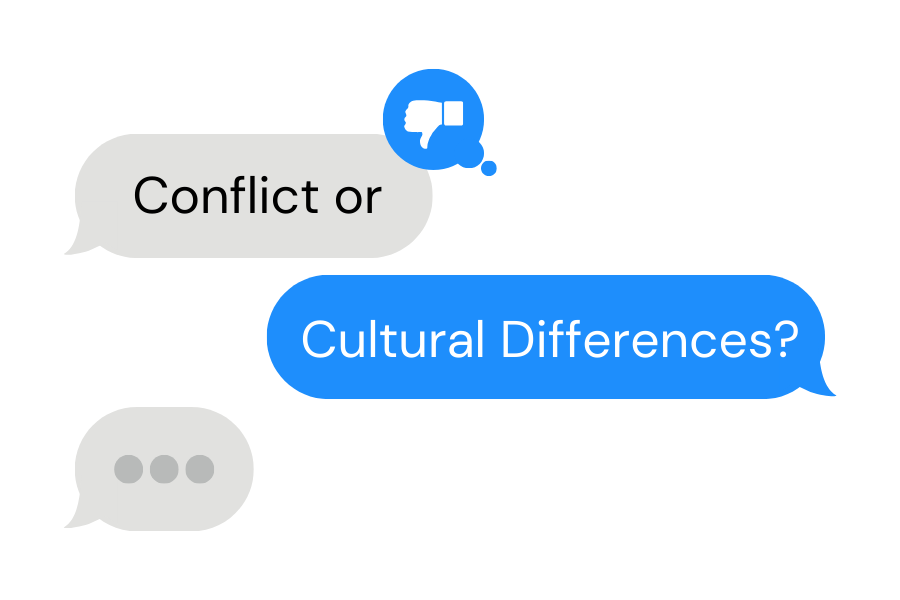Conflict or Cultural Differences?
January 10, 2025

"Culture is more often a source of conflict than of synergy. Cultural differences are a nuisance at best and often a disaster." ~ Geert Hofstede
Sometimes seemingly small cultural differences can evolve into conflict. In our increasingly diverse, multi-cultural, international community, differences and misunderstandings based on culture can impact our personal and professional lives. One of the biggest challenges of cultural differences is that our culture is so ingrained in us that most of us think that our way is the only way. Simply being aware of the role culture and that behaviors are often culturally based, helps mitigate potential conflict.
Consider our relationship to time. Americans are very much linear-time people. You may ask, “Isn’t everyone?” The answer is a resounding, “No!” For an American who has an appointment scheduled for 9:00, they will expect that it will begin, if not at 9:00 sharp, at least by 9:05. While Americans are not as linear time focused as the Germans and the Swiss (that appointment better not begin 1 minute after 9:00!), we are very time-centric. The United States is a very large and diverse country so there certainly are some regional differences (the Northeastern states are more concerned with time than Southerners, for example) but our average is still far closer to the Germans and Swiss than for example, Latin Americans or Africans. Other cultures from countries such as India, Nigeria, and Saudi Arabia are far more flexible with time. When an invitation to a party in Brazil says 7:00 p.m. For example, it can be considered rude to show up before 8:00 p.m. as you might catch the host in the shower! Understanding that time is cultural can first help prevent misunderstandings from occurring. The individual who kept you waiting for 20 minutes without texting wasn’t intending to be disrespectful – this is simply a cultural difference.
There are many common areas of cultural differences that can lead to potential conflict. Some of these tend to be more common in the business world such as how direct or indirect we are in giving criticism, whether we are more top-down or consensus focused in making decisions, whether we are more apt to use principles or application first in persuasion. Outside of the workplace, there are even more possibilities for cultural misunderstandings – our sense of self and space is just one. Think for a moment how close you commonly stand when talking to a friend. How much person space we require is cultural. Americans live in a large country where there is a lot of space – we require more personal space than someone from a smaller Asian country for example, who need less personal space. An American conversing with a Vietnamese or Venezuelan person may find them suffocatingly close and be uncomfortable. Conversely, the Latin American or Asian may find the excessive personal space the American needs rude and distant. Our sense of self is also cultural. Independence and self-reliance are highly valued in American culture whereas in Japan, for example, conformity and group cooperation are critically important.
Perhaps the most common area for cultural misunderstandings is in communication. Cultures are generally viewed as being verbal, low-context cultures or nonverbal, high context cultures. Americans tend to be a very verbal, low-context culture. Our attention is placed on what is being said rather than what is left unsaid and our relatively bad at “reading between the lines.” In fact, we tend to sum up meetings by recapping what was said, repeating important points, and when in doubt, the phrase, “Let me be clear” may be used to preface a statement. In striking contrast, many Asian cultures are highly nonverbal and high context, and are very indirect in their communication style (according to Westerners). Problems can emerge when an American thinks that their Korean friend agreed with them whereas the Korean thinks they were very clear in communicating their disagreement with their American friend. Both individuals think they are right, the other wrong, trust is broken, and potential conflict can emerge.
How do we prevent cultural differences from creating conflict? When interacting with someone from a different background than one’s own, be aware that cultural differences exist and are often hidden. Simply understanding that the issue stems from cultural differences rather than intentional rudeness can often eliminate the heat of conflict. The most effective way to prevent conflicts resulting from culture is to discuss cultural differences. The next time you make plans with your Nigerian friend, discuss how you both see time differently and together plan for working with these cultural differences in the future.
Maintain respect and be non-judgmental – the other person’s way is different, not incorrect. Remember that your way of doing things is just that – your way. It isn’t the right way. Be patient and empathetic. Remember persistence is critical – even with the pitfalls inherent in cross-cultural relationships, the benefits far outweigh the inconveniences.
K. Kelly O’Connor, MA, CFRE
Lipscomb University Institute for Conflict Management
College of Leadership and Public Service News